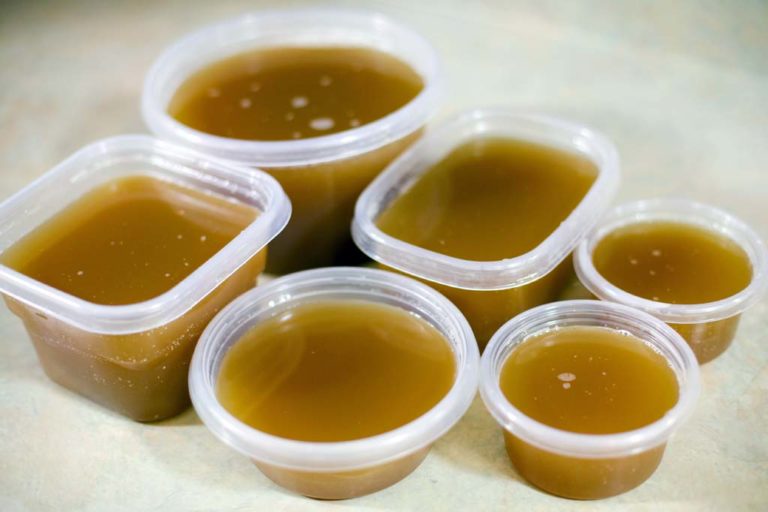
Chef's notes:
Until I started really getting into cooking, I hadn’t really considered the prospect of making game stock from venison or ruffed grouse bones. From my former perspective, they were waste and should just be thrown in the trash. But as I got into cooking a bit more, I realized that there is really no such thing as waste in the kitchen. Everything can and, from my current perspective, should be used. So last year I made plans to save some venison bones along with some grouse bones to make game stock. The recipe came from Larousse Gastronomique, by Prosper Montagné. The book is a very old encyclopedia of food, wine, and cookery originally published in France in 1938. It is one of my favorite books to flip through and read random bits of kitchen wisdom. It is this very book that has inspired so many of the recipes and cooking techniques that I use on my website. That and Monsieur Pepin.
Ingredients
- 5 lbs bones: venison, rabbit, or game bird
- 2 cups onion, chopped
- 1 cup celery, chopped
- 1 cup carrot, chopped
- 1 tsp sage
- 1 whole clove
- 1 garlic clove
- 1 tsp thyme
- ½ tsp black pepper
- 1 bay leaf
- 8 juniper berries
Game Stock Recipe: Roast Venison and Grouse Bones Simmered with Roast Mirepoix and a Sachet of Herbs
- For this brown stock, we need to roast the bones. Roast the bones in a 350-degree oven for 30 minutes until dark brown. The roasting will enrich the flavor of the stock and it will help to render some of the fat off the meat and bones. Plus, I can’t imagine what I might do with a light game stock. But that could be in part because I am planning on making a glace with some of this stock. Darker stocks seem to work better for meat glaces.
- We also need to roast the mirepoix. After we finish roasting the bones we need to roast the mirepoix in the same pan. This will help to get some of the fond off the bottom of the pan. This stuff stuck to the bottom of the pan, so long as it isn’t burned, will give our stock even more flavor. The vegetables will need to be flipped every 8 minutes as they roast for the next 20 minutes.
- Simmering the bones and mirepoix in water. Put the bones in a stock pot and cover with cool water. Cover the bones by a couple inches and turn the heat up. You may place the lid on to help the pot heat up, but once it’s hot, remove the lid. As the liquid simmers, skim off any floaty bits. Simmer the bones for 2 hours before you add the mirepoix. Keep skimming the floating stuff and oil that comes to the top. Once the mirepoix is in the pot, simmer for another 4 hours.
- Put the bones in a stock pot and cover with cool water. Cover the bones by a couple inches and turn the heat up. You may place the lid on to help the pot heat up, but once it's hot, remove the lid. As the liquid simmers, skim off any floaty bits. Simmer the bones for 2 hours before you add the mirepoix. Keep skimming the floating stuff and oil that comes to the top. Once the mirepoix is in the pot, simmer for another 4 hours. Tie the herbs into a envelope of cheesecloth. Or tie them in a bunch with some butcher’s twine. Or, if you’re feeling really lazy, just toss them in loose. I mean, you’re gonna be straining them out along with everything else in an hour anyway.
- Strain out the bones and everything else. After another hour and a total cooking time of 7 hours, taste the stock to see how it’s coming. Since there is no salt in the recipe, it may be hard to taste it. But the stock should be somewhat rich and full-bodied in flavor, and yet watery. Try adding salt to a spoonful to help get a taste. If isn’t done, simmer for another hour or two until it is. Then use a wire strainer or spider to remove the large pieces of bone and vegetable. Then pour the rest through a sieve or a cheesecloth lined colander.
- Cool the stock in an ice bath. Put the stock into a stock pot and into an ice bath to cool. Stir the mixture until it’s around 100 degrees F. Alternatively, you could put the stock into several shallow pans to cool in the fridge. But honestly, the ice bath is much quicker, safer, and easier. Once the stock is cool, pour into containers and freeze. Make sure to leave room at the top, as the stock will expand as it freezes.
Tips & Tricks
- You may substitute some chicken bones for the game bird bones if you are unable to come up with enough.
- Rabbit bones were in the original recipe. As were whole chunks of meat. But that’s not really necessary, as the bones provide more then enough flavor. You just have to figure out how to get it out.
- The vegetable and herb flavors will become destroyed if we cook the stock too long, which is why we add them later in the cooking process.
